A Petra Island house rises from Frank Lloyd Wright's original drawings
Based on Frank Lloyd Wright drawings, the cantilevering Petra Island Massaro House, located in New York’s Hudson Valley, is now open to visitors
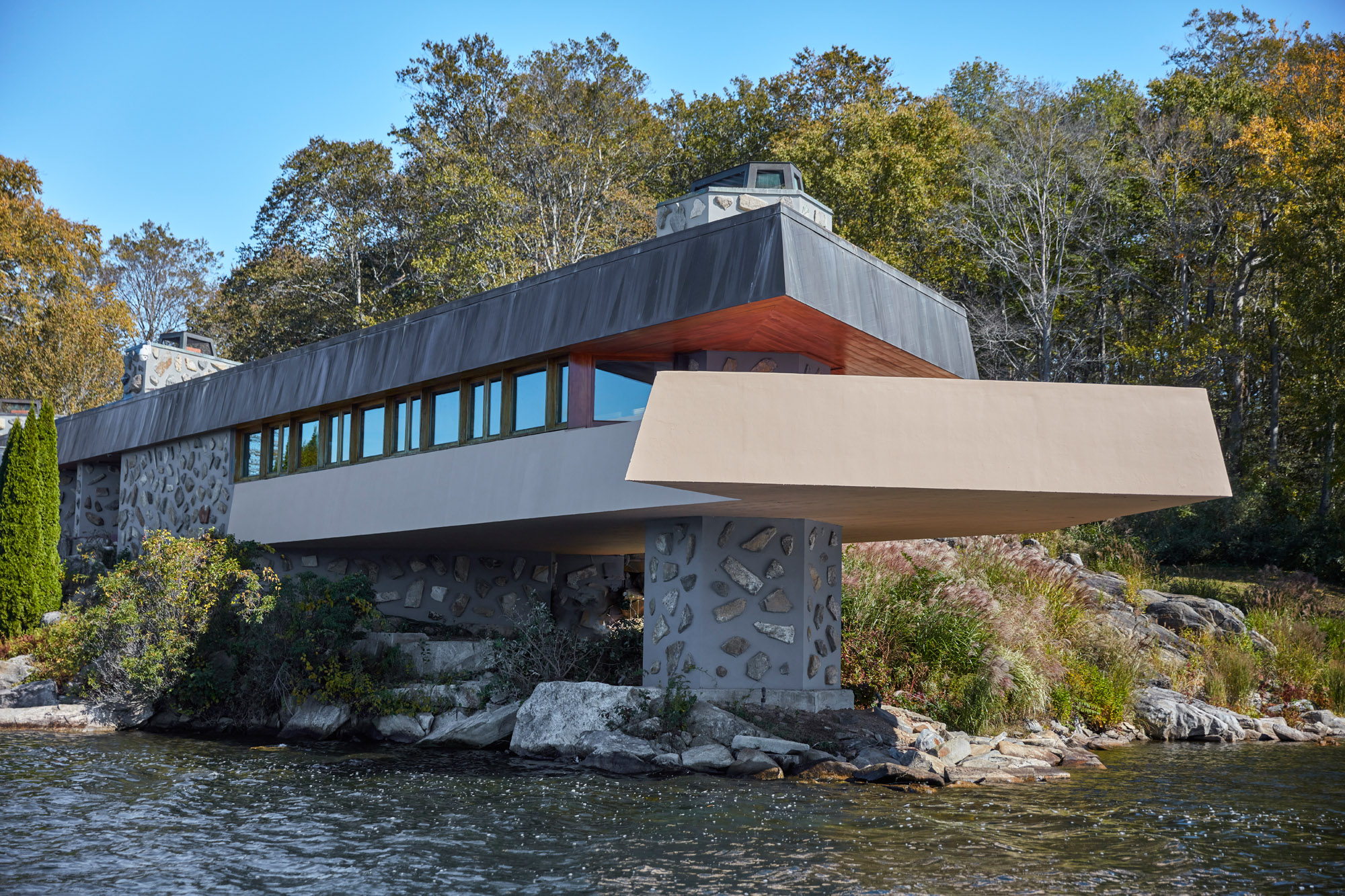
Joe Massaro’s personal charm and determination should not be underestimated. Many before him had tried and failed to realise Frank Lloyd Wright’s proposal for a 5,000 sq ft residence on Petra Island, a heart-shaped private islet on Lake Mahopac, in New York’s Hudson Valley.
Massaro, who grew up down the road in Elmsford, paints himself as an unlikely champion for the build. He was not born into a design family. After school, his parents discouraged him from joining their service station as an auto mechanic. Instead, he fabricated forced-air ducts for industrial buildings and crossed paths with the eminent US architect IM Pei on one big sheet metal job in the 1980s. That was, however, still leagues away from the architectural milieu of Frank Lloyd Wright – the godfather of modern house design, who was born in Wisconsin in 1867 and died more than six decades ago. Wright was already an éminence grise in the 1940s when a wealthy builder first ferried him by boat to Petra, 11 uninhabited acres forested with trees. Even today, touring the island requires a reservation since it has neither roads on it nor a bridge to it.
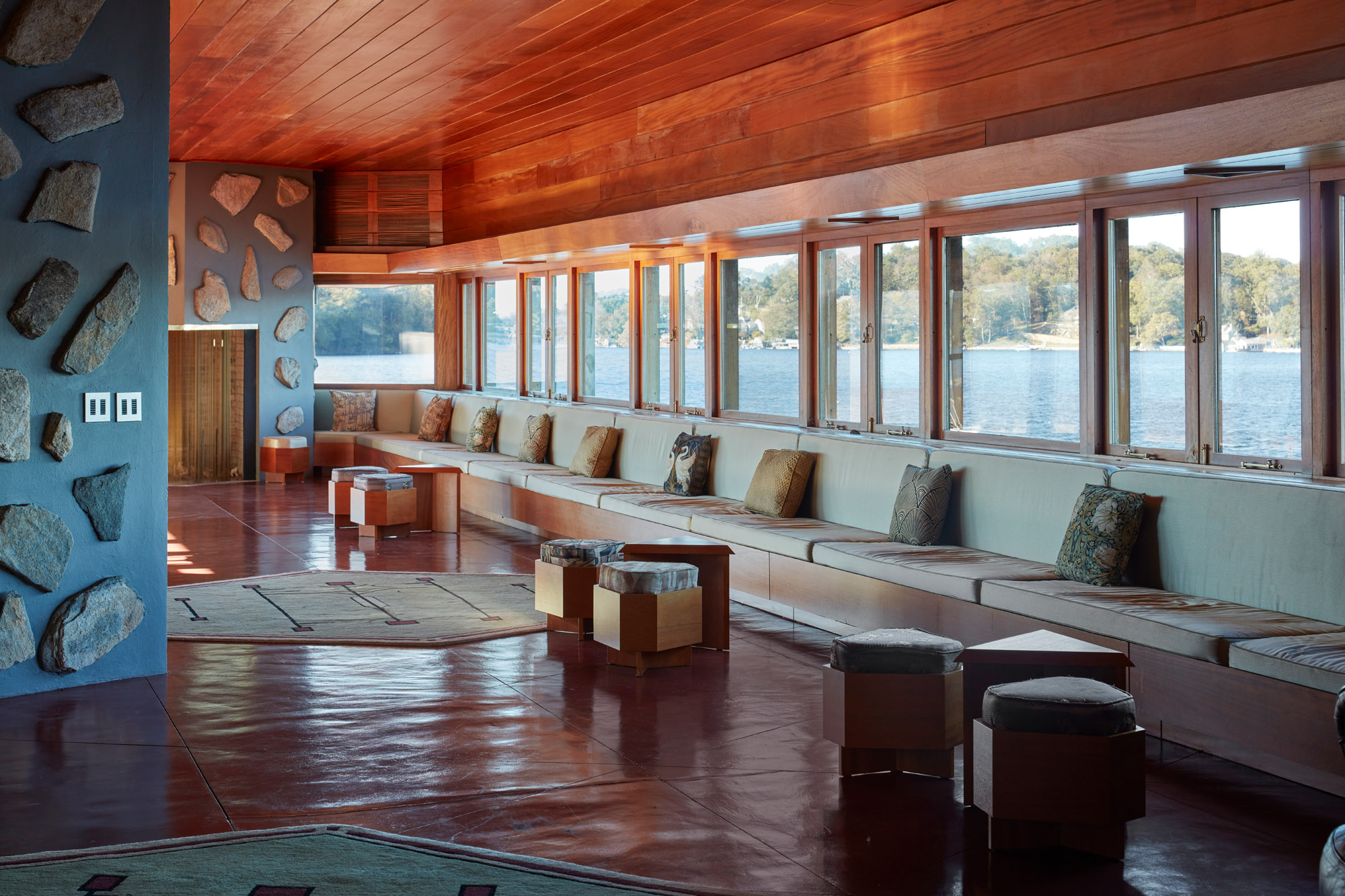
The cantilevered section houses an elongated room with banquettes and a double-sided fireplace that links with a large terrace overlooking the lake
Massaro House on Petra Island
Wright was enchanted by the prospect of building there. His proposal was bold, futuristic and made the most of its site, the home’s living room boasting water views akin to being on a cruise ship. But construction would prove prohibitively expensive, plus the scheme also flouted mandatory setbacks from the water. In defeat, Wright completed only a modest 1,100 sq ft cabin on the island, farther from shore, in 1951.
A succession of subsequent owners applied for regulatory approval for the unbuilt mansion. At one point, seeking money from investors, someone invited Massaro himself to a picnic on the island – by then he had taken over his uncle’s sheet metal business, which flourished. He brought homemade chilli for the hotdogs, but declined to buy in.
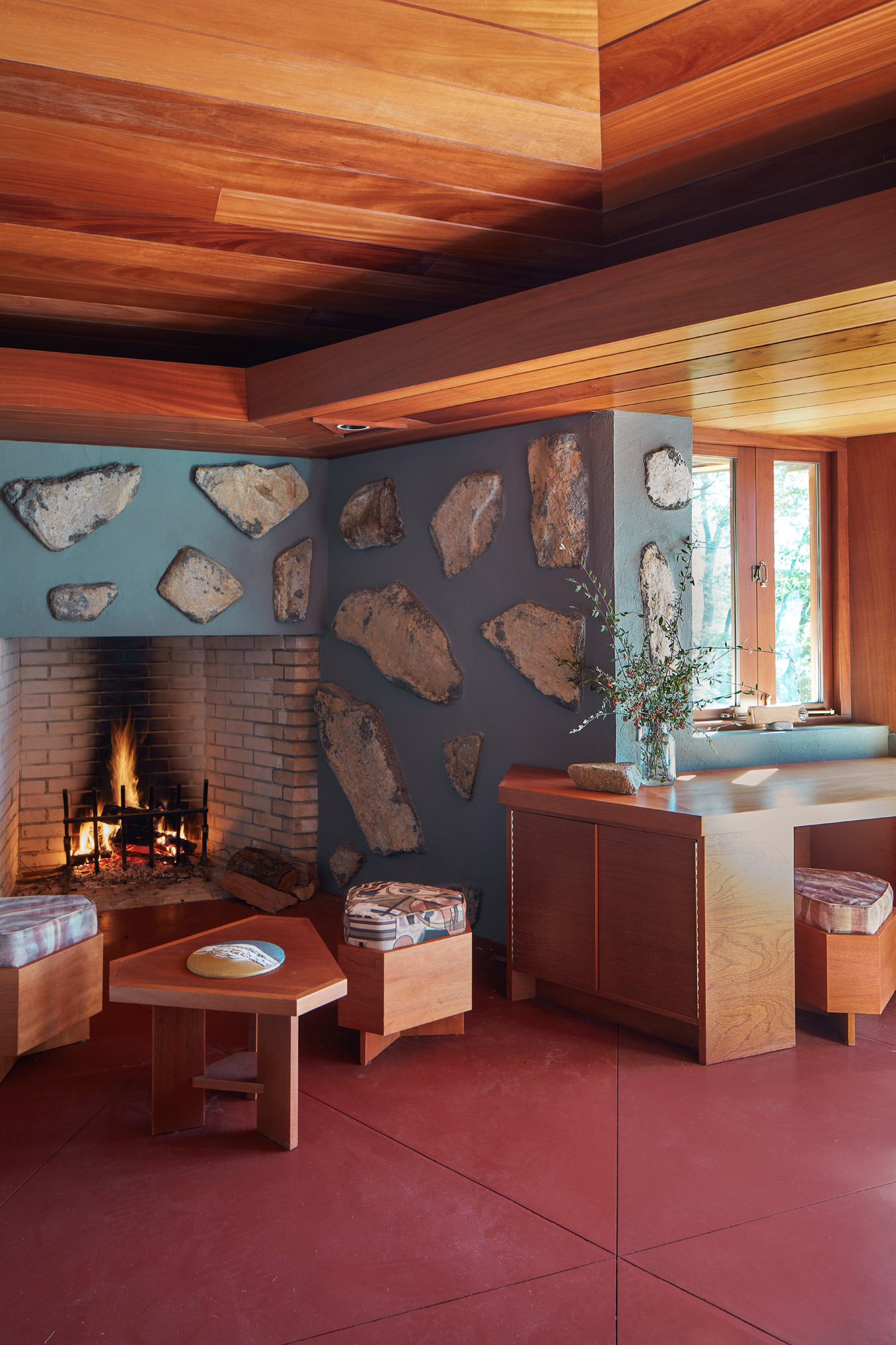
Walls studded with local granite rocks are meant to resemble Wright’s ‘desert masonry’, used in the building of the architect’s winter home, Taliesin West
The project would change hands once more before Massaro offered to purchase the island outright. He recounts the day he piloted his WaveRunner to the Wright-designed dock, where he taped up a clear plastic sandwich bag containing notepaper with his phone number scrawled onto it, trying to get in touch with the owner to make an offer. Guard dogs chased him off so fast that he left his roll of tape behind.
Massaro secured the title to the island in 1995 in trade for another lakefront house he owned on Mahopac plus some cash. As owner, he spent weekends in the Wright-designed cabin and tackled small repairs. Years passed before he even thought about trying to build the mansion: ‘A normal person wouldn’t do it!’ Finally allowing himself to dream, he went for it, committing to Wright’s original vision as if the master were still alive. Building it proved, predictably, a tricky ride.
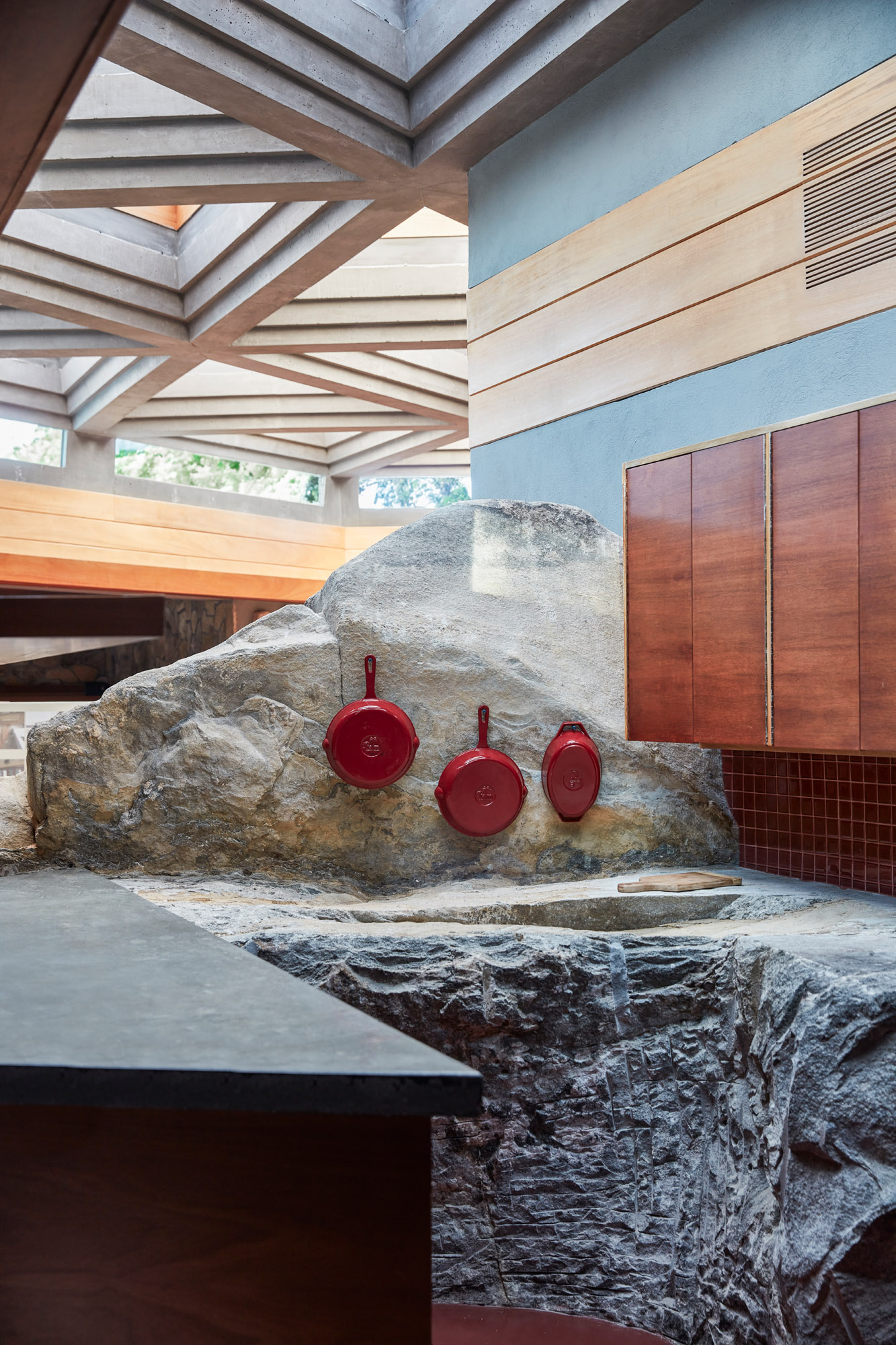
The site’s stone outcrops are incorporated into the interior, such as in the kitchen...
Massaro had to fight to place the building astride the forbidden waterline, exactly as Wright had proposed. ‘I’m not big with rules, especially if they don’t make any sense,’ he says. The precise location for the home’s footprint was easy to pinpoint thanks to structural clefts still clearly visible in the native stone outcroppings – and also delineated in five scale drawings that Wright prepared during his lifetime. The Frank Lloyd Wright Foundation helped with producing fresh renderings for Massaro to explain the vision, and to charm the local authorities into granting an exception – and the exception was granted. ‘People feel comfortable with me,’ he says, with his trademark warmth.
Wallpaper* Newsletter
Receive our daily digest of inspiration, escapism and design stories from around the world direct to your inbox.
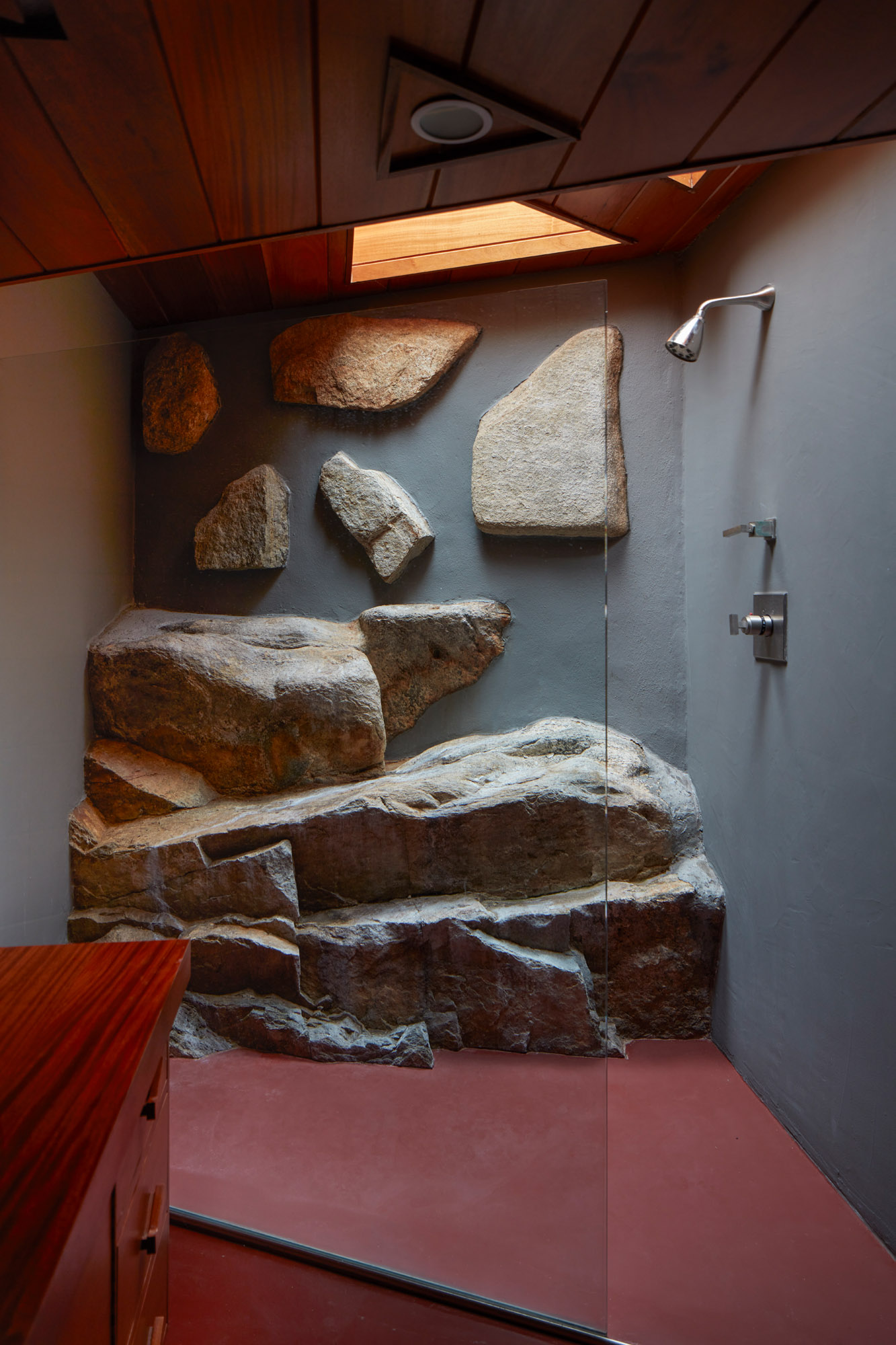
... and guest shower room, while 26 triangular skylights flood the house with light
Massaro also needed construction plans. He explored working with the Wright Foundation on the build, but eventually he went ahead independently, enlisting Illinois-based architect Thomas Heinz, an authority on Wright, to prepare some detailed construction drawings. Heinz had already tackled two dozen Wright-related projects at that point. Perhaps most notable among these is the 1912-1914 Frank Lloyd Wright Room, from the Francis W Little House in Minnesota, which was meticulously salvaged for reinstallation at New York’s Metropolitan Museum of Art.
Then there were the logistical obstacles in planning building work on the island. Visitors who book a 90-minute Petra Island tour today meet at the private boat dock on the mainland, and the transfer feels pretty straightforward. But practical hurdles around construction on the site cannot be overstated. The crew had to wait for the lake to freeze over in winter so an excavator could drive across the ice to the island from shore.
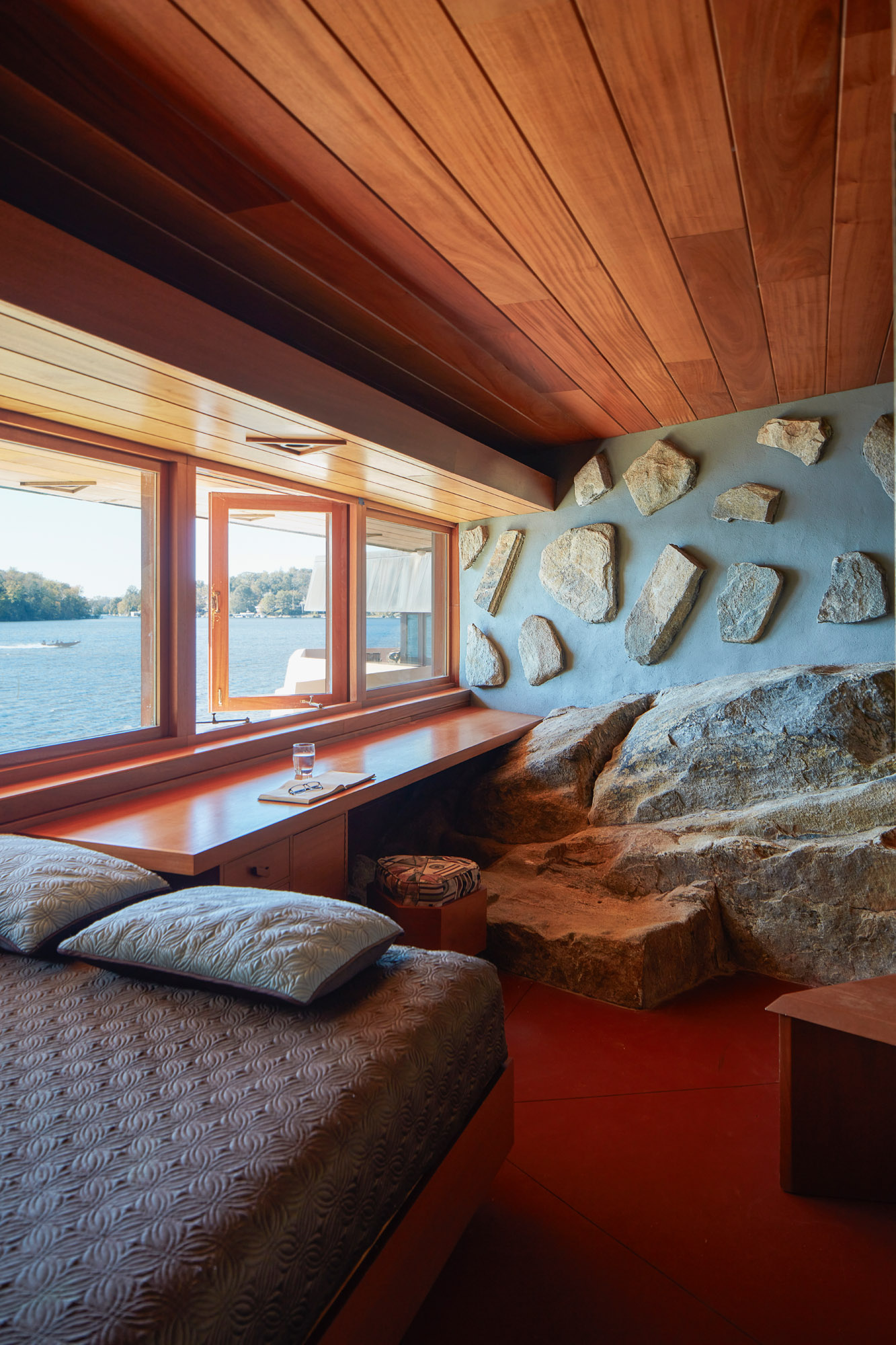
The home's long strips of windows offer views of the lake
Heinz notes that the original drawings for the mansion did not call out dimensions. Fortunately, they were precisely drawn to scale and could be measured. All the wooden windows are bespoke. As at the Wright cabin across the lawn, and as found in many other projects by the architect, the mansion floors are red concrete. And following the example of Fallingwater (a private residence in southwestern Pennsylvania designed by Wright in 1935 and considered one of his greatest masterpieces), the spectacular native rock outcrop here bursts through the foyer’s polished floor, just as Wright intended.
It was challenging to conform to the modern energy-conservation codes that Wright could never have anticipated. Heinz says he had to use the latest state-of-the-art technology available, such as halogen spotlights, when construction began, finally, in the early 2000s.

Set on its rocky terrain, the home appears to emerge from the land
Perhaps a few other details of the mansion wither under close inspection. The ‘desert masonry’ technique used in the cabin – and seen also on a larger scale all over Taliesin West (Wright’s winter home and studio in the desert at Scottsdale, Arizona, designed in 1937) – could not be replicated precisely for the new structural concrete walls. They got laminated with a sprinkling of stone. ‘I think the rocks are too far apart, but that was up to Joe,’ says Heinz. Recalling Wright’s austere, suited and often caped figure, as seen in period photos, a visitor might be surprised to hear Heinz mention the master’s flexibility and deference to owners’ preferences: ‘He would do whatever pleased his client.’
Massaro House, Petra Island, NY, is open to visitors by appointment only
A version of this article appears in the May 2024 issue of Wallpaper*, available in print, on the Wallpaper* app on Apple iOS, and to subscribers of Apple News +. Subscribe to Wallpaper* today
Architecture-trained Craig Kellogg’s first article for Wallpaper magazine appeared in issue 6. He has contributed to The New Yorker and The New York Times, and he lives in the East Village of Manhattan, where he works as a creative director.
-
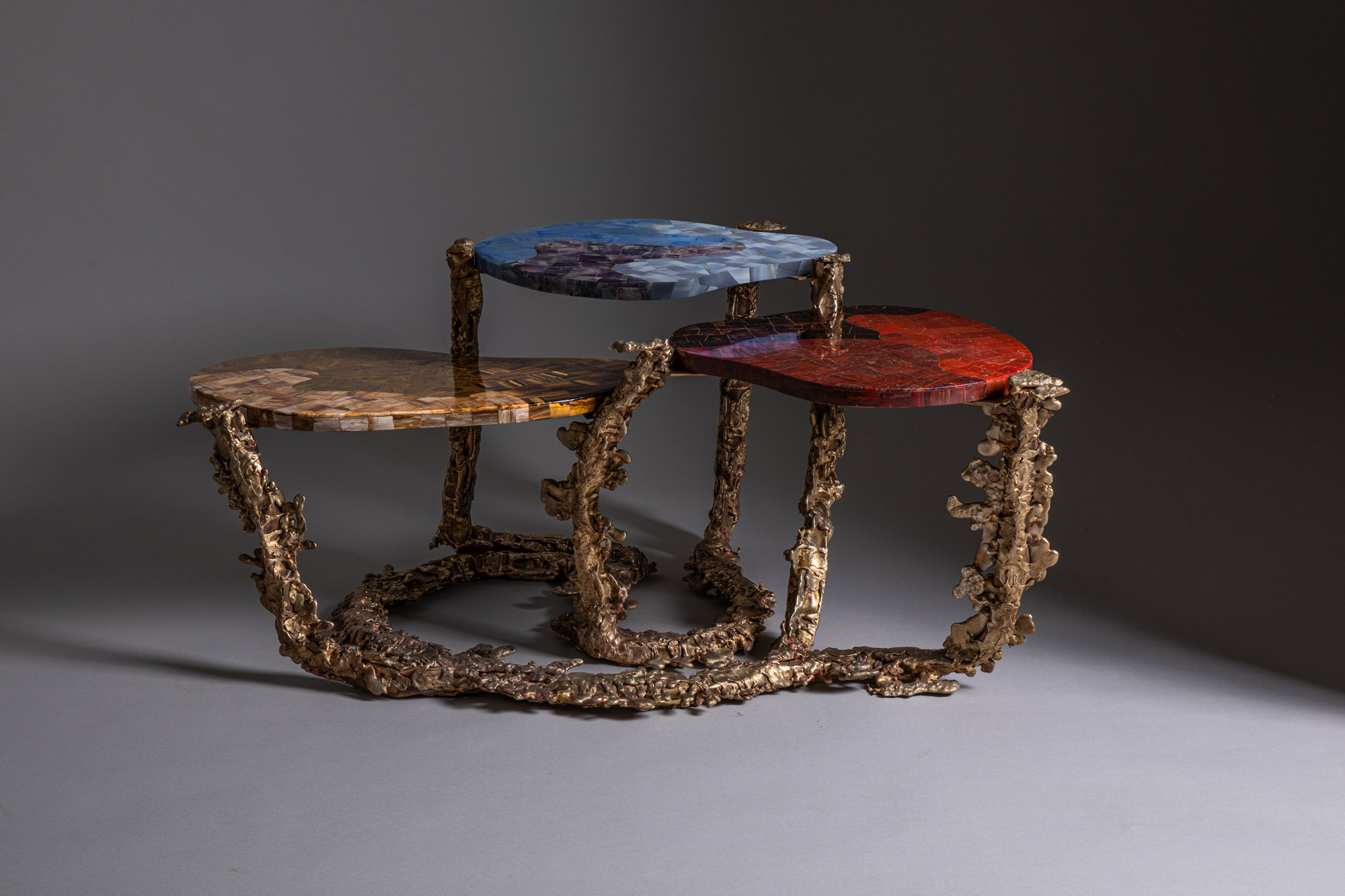 Inside the Shakti Design Residency, taking Indian craftsmanship to Alcova 2025
Inside the Shakti Design Residency, taking Indian craftsmanship to Alcova 2025The new initiative pairs emerging talents with some of India’s most prestigious ateliers, resulting in intricately crafted designs, as seen at Alcova 2025 in Milan
By Henrietta Thompson Published
-
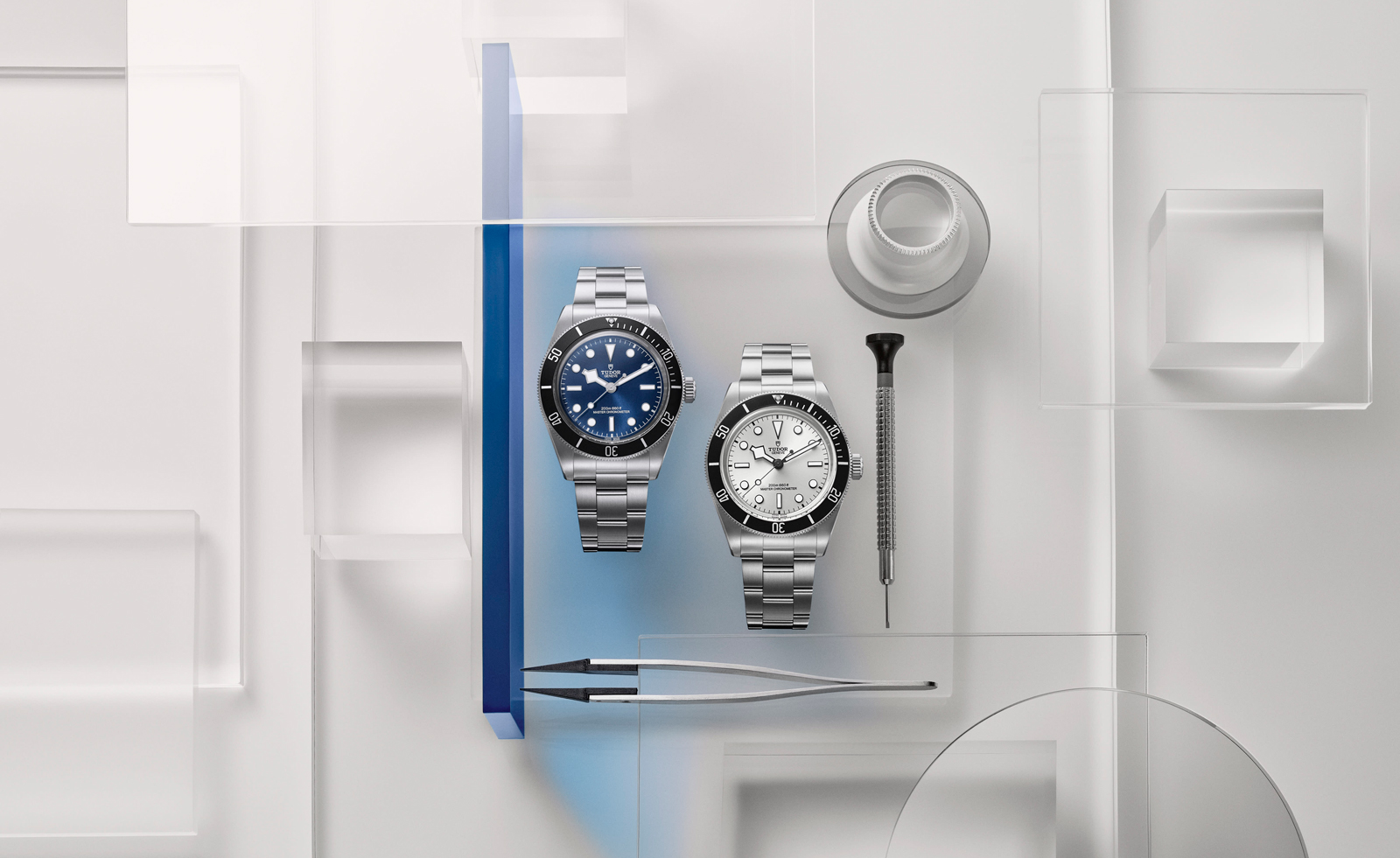 Tudor hones in on the details in 2025’s new watch releases
Tudor hones in on the details in 2025’s new watch releasesTudor rethinks classic watches with carefully considered detailing – shop this year’s new faces
By Thor Svaboe Published
-
 2025 Expo Osaka: Ireland is having a moment in Japan
2025 Expo Osaka: Ireland is having a moment in JapanAt 2025 Expo Osaka, a new sculpture for the Irish pavilion brings together two nations for a harmonious dialogue between place and time, material and form
By Danielle Demetriou Published
-
 We explore Franklin Israel’s lesser-known, progressive, deconstructivist architecture
We explore Franklin Israel’s lesser-known, progressive, deconstructivist architectureFranklin Israel, a progressive Californian architect whose life was cut short in 1996 at the age of 50, is celebrated in a new book that examines his work and legacy
By Michael Webb Published
-
 A new hilltop California home is rooted in the landscape and celebrates views of nature
A new hilltop California home is rooted in the landscape and celebrates views of natureWOJR's California home House of Horns is a meticulously planned modern villa that seeps into its surrounding landscape through a series of sculptural courtyards
By Jonathan Bell Published
-
 The Frick Collection's expansion by Selldorf Architects is both surgical and delicate
The Frick Collection's expansion by Selldorf Architects is both surgical and delicateThe New York cultural institution gets a $220 million glow-up
By Stephanie Murg Published
-
 Remembering architect David M Childs (1941-2025) and his New York skyline legacy
Remembering architect David M Childs (1941-2025) and his New York skyline legacyDavid M Childs, a former chairman of architectural powerhouse SOM, has passed away. We celebrate his professional achievements
By Jonathan Bell Published
-
 The upcoming Zaha Hadid Architects projects set to transform the horizon
The upcoming Zaha Hadid Architects projects set to transform the horizonA peek at Zaha Hadid Architects’ future projects, which will comprise some of the most innovative and intriguing structures in the world
By Anna Solomon Published
-
 Frank Lloyd Wright’s last house has finally been built – and you can stay there
Frank Lloyd Wright’s last house has finally been built – and you can stay thereFrank Lloyd Wright’s final residential commission, RiverRock, has come to life. But, constructed 66 years after his death, can it be considered a true ‘Wright’?
By Anna Solomon Published
-
 Heritage and conservation after the fires: what’s next for Los Angeles?
Heritage and conservation after the fires: what’s next for Los Angeles?In the second instalment of our 'Rebuilding LA' series, we explore a way forward for historical treasures under threat
By Mimi Zeiger Published
-
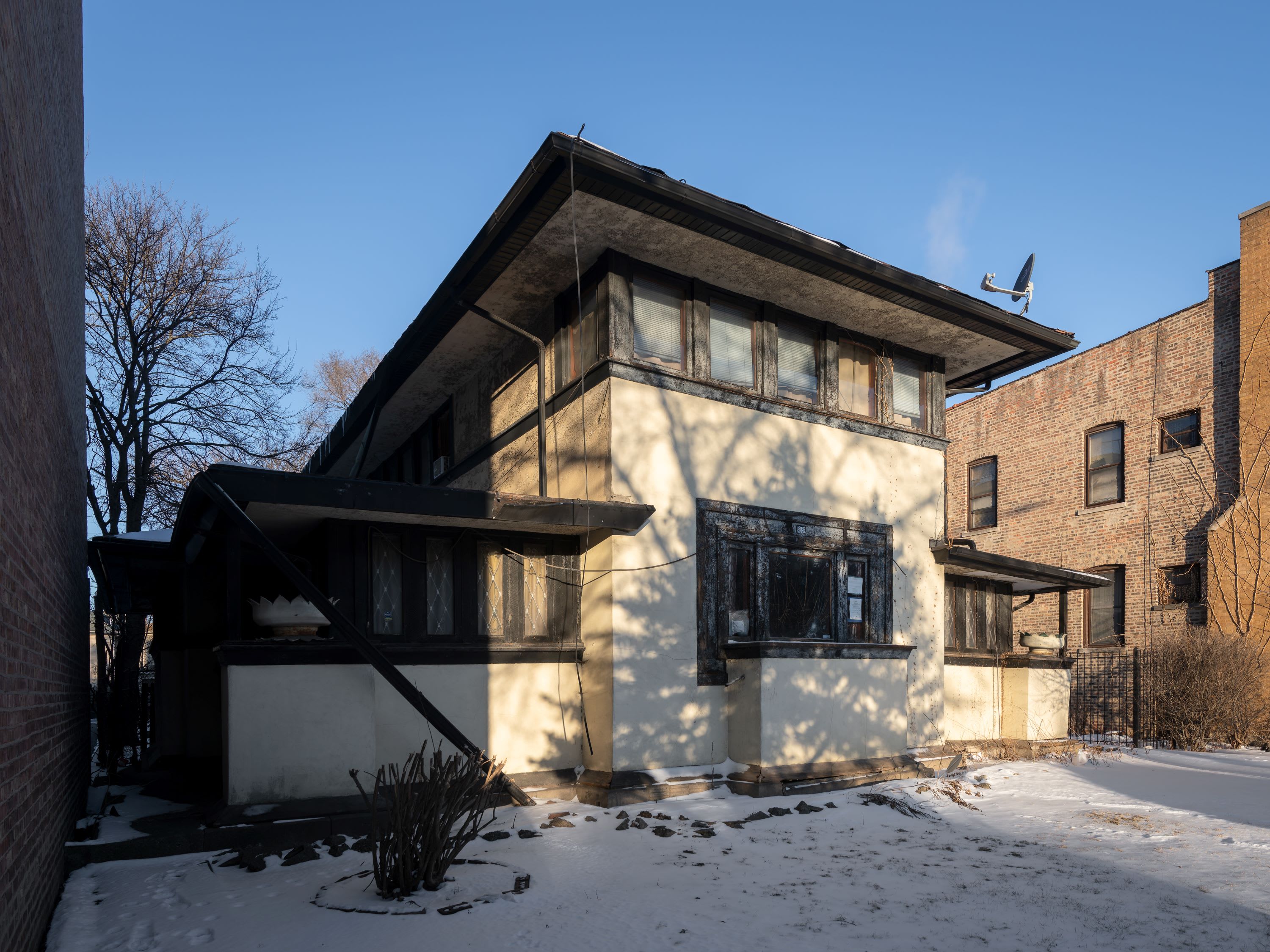 Why this rare Frank Lloyd Wright house is considered one of Chicago’s ‘most endangered’ buildings
Why this rare Frank Lloyd Wright house is considered one of Chicago’s ‘most endangered’ buildingsThe JJ Walser House has sat derelict for six years. But preservationists hope the building will have a vibrant second act
By Anna Fixsen Published